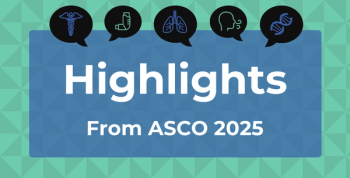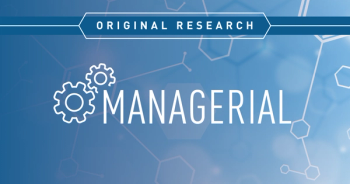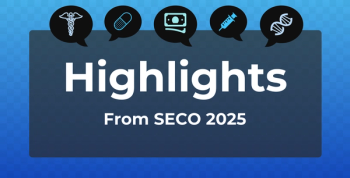
- August 2025
- Volume 31
- Issue Spec. No. 9
- Pages: SP623-SP624
Remote Clinical Pharmacists Saved Nearly $9M, Helped Practices Meet EOM Targets

Key Takeaways
- Remote clinical pharmacists reduced TCOC by $8.98 million for five practices in The US Oncology Network over 18 months.
- Six medication strategies, including dose banding and biosimilar interchange, were key to achieving significant cost savings.
A team of 7 remote clinical pharmacists helped 5 practices in The US Oncology Network reduce total cost of care (TCOC) by $8.98 million over the first 18 months of the CMS Enhancing Oncology Model (EOM). Early data show that the effort has already helped 3 practices earn a performance-based payment.1
Results from the initiative, presented in June during the annual meeting of the American Society of Clinical Oncology (ASCO), have since been published in the Journal of Oncology Practice, an ASCO publication.2
The EOM, which succeeded CMS’ Oncology Care Model (OCM), launched July 1, 2023, to offer participants opportunities to earn performance-based payments (PBPs) if they achieved savings above a preset benchmark.3 EOM requirements are considered more challenging than those in the OCM; although 44 practices signed up at the outset, today 38 remain.3
Because drug costs account for so much of patients’ TCOC, The US Oncology Network (The Network) sought a way to help its 12 EOM practices achieve savings at scale. Ultimately, 5 practices in The Network that joined the EOM took part in the remote pharmacy initiative.2
Daniel C. Kendzierski, PharmD, BCOP, the study’s lead author, explained in an email to Evidence-Based Oncology (EBO) that the remote team, known as clinical review pharmacists (CRPs), offered participating practices access to reviews for each order, so they could identify opportunities for savings based on 6 specific initiatives pursued by The Network.
As the authors state, “Interventions were tracked by the CRP, and TCOC reduction was calculated using the difference between the CMS allowable for the original treatment ordered and the new order.”
Kendzierski said the initiatives supported by the CRPs were: monoclonal antibody dose rounding, pembrolizumab dose banding, biosimilar therapeutic interchange, use of a preferred PD-1 agent to treat metastatic non–small cell lung cancer, reduced upfront use of long-acting growth factors, and use of the bone-modifying agent zoledronic acid over more expensive alternatives. In the email, he said these initiatives reduced “without compromising clinical outcomes.”
Results showed that from July 1, 2023, to December 31, 2024, the CRPs evaluated 5600 patients, with 1180 of interventions adopted by practices, with 93% of recommendations accepted. Authors found that the projected amount of savings was $1604 per patient (in US Dollars). Beyond the 6 initiatives, the remote pharmacists helped save an additional $1.2 million associated with drug selection.2
In addition, the authors evaluated how the CRP efforts helped practices meet EOM targets. They wrote that a comparison of the results with preliminary data for performance period 1, which ran from July 1 to December 31, 2023, “validated the significant cost savings and PBP of over $3.3 [million], which our efforts supported, reinforcing the effectiveness of the medication-related strategies.”2
Regarding the EOM, they wrote that these results translated into “savings percentage against benchmark during PP1 of 5.7%, 8.1%, and 23.6% across 3 evaluable sites.” The authors noted that spending on drugs accounted for 72%, 77%, and 75% of TCOC, “reflecting that most of the total health care costs were attributed to medication-related initiatives within the EOM,” for the performance period. All 3 were on track to receive a PBP, the authors said. EOM sites were also projected to achieve higher TCOC reductions than the non-EOM sites.
“This study demonstrates that pharmacist-led medication initiatives can significantly reduce the total cost of cancer care” the authors concluded.
Kendzierski responded to questions about the initiative from EBO as follows.
EBO: Can you discuss how clinical pharmacy review worked in practice during the first year of the EOM?
Kendzierski: Pharmacists developed practice-specific policies to facilitate efficient implementation of the 6 strategies, which were subsequently approved by governing bodies, such as Pharmacy and Therapeutics Committees. CRPs were tasked with reviewing new and existing orders to identify cost-saving opportunities, updating eligible treatments according to practice protocols, or consulting with the treating oncologist as necessary.
Practice performance based on initiatives adopted were evaluated on a quarterly basis during business reviews and practice stakeholders were able to provide feedback regarding the EOM initiative workflow. Each intervention was entered by the CRP into an internal tracking system and was manually marked as an EOM-related intervention.
EBO: Did all practices in the US Oncology Network participate in clinical pharmacy review, or just those in the EOM?
Kendzierski: Not all practices in the network utilize the CRP program to provide remote clinical pharmacy services by oncology-trained pharmacists. At present, 13 practices within the network utilize the program. Specifically, 5 of the 12 EOM-participating practices in The Network utilized the program during the study period. These practices voluntarily adopted the pharmacist-led initiatives, and the extent of initiative adoption varied by site.
EBO: Some interventions brought more savings than others. Were there any surprising results in the savings across the interventions?
Kendzierski: Yes, there were some notable and perhaps unexpected findings in the savings data: First, pembrolizumab dose banding, though applied in only 8% of interventions, had the highest average savings per intervention at $18,510, totaling nearly $2 million in TCOC reduction. Second, zoledronic acid substitution also stood out, contributing over $2.1 million in savings with an average of $11,992 per intervention.
In contrast, monoclonal antibody dose rounding and biosimilar therapeutic interchange, while more frequently used (35% and 28% of interventions respectively), had lower average savings per intervention ($3,470 and $4,244 respectively). These results highlight that even less frequently used interventions can yield disproportionately high savings, especially when targeting high-cost drugs.
EBO: How would you describe the buy-in for this approach among the participating practices?
Kendzierski: Buy-in among participating practices appeared strong. Of the 1271 interventions proposed by CRPs, 93% were accepted and implemented by treating oncologists. Practices had autonomy in selecting which initiatives to adopt, and all 5 participating practices implemented at least 4 of the 6 core initiatives. Importantly, no additional pharmacist staffing or budget increases were required, which likely facilitated adoption. Feedback mechanisms were in place through quarterly business reviews, allowing practices to provide input and refine workflows collaboratively.
EBO: Is the process continuing? Have there been any changes, such as additional interventions?
Kendzierski: Yes, the process is continuing to date, although our study results spanned through December 31, 2024. Although the 6 core initiatives remained the foundation, some practices also adopted additional medication strategies for further cost savings as new drugs are coming to market. These included:
- Substituting generic medications for 505(b)(2) drugs such as utilizing Aloxi instead of Posfrea (when prescribing palonosetron, an anti-nausea agent).
- Limiting use of higher-cost medications when clinically appropriate alternatives existed (such as neurokinin-1 antagonists, Abraxane/nab-paclitaxel).
These additions reflect a growing sophistication and customization of the program at the practice level.
References
1. Kendzierski DC, Basilio AJ, Roman AR, et al. Remote clinical pharmacist impact on reducing total cost of care in Enhancing Oncology Model–enrolled oncology practices. J Clin Oncol. 2025;43(suppl 16): Abstract 1501. doi:10.1200/JCO.2025.43.16_suppl.1501
2. Kendzierski DC, Basilio AJ, Roman AR, et al. Remote clinical pharmacist impact on reducing total cost of care in Enhancing Oncology Model–enrolled oncology practices. JCO Oncol Pract. Published online June 2, 2025. doi:10.1200/OP-25-00333
3. Enhancing Oncology Model. CMS. Updated July 1, 2025. Accessed July 29, 2025. https://www.cms.gov/priorities/innovation/innovation-models/enhancing-oncology-model
Articles in this issue
Newsletter
Stay ahead of policy, cost, and value—subscribe to AJMC for expert insights at the intersection of clinical care and health economics.







































